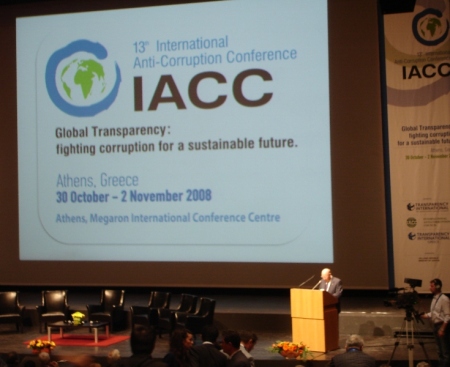Are citizens changing the rule of the game?
 This year, the International Anti-Corruption Conference has not only a session, but a whole stream focussing on a wide range of initiatives that put the citizens at the centre of the fight against corruption. A “Paradigm Shift”, as the conference calls it. The special sessions run under the title Changing the Rules of the Game, and looks at how people are mobilised, ways of supporting victims, witnesses and whistleblowers, and how to connect these [game]changers.
This year, the International Anti-Corruption Conference has not only a session, but a whole stream focussing on a wide range of initiatives that put the citizens at the centre of the fight against corruption. A “Paradigm Shift”, as the conference calls it. The special sessions run under the title Changing the Rules of the Game, and looks at how people are mobilised, ways of supporting victims, witnesses and whistleblowers, and how to connect these [game]changers.
This blog has been started 2 years ago, for the 13th International Anti-Corruption Conference, as part of a session entitled “ACOUNTABILITY 2.0 : Using Social Media in the Fight Against Corruption“. It proposed to:
…demonstrate how social media is used to advance corporate social responsibility, government accountability and political integrity and human rights (and) provide a platform to share practical experience with these tools with a broader governance and anti-corruption audience and inspire a discussion on how social media tools can be best appropriated for the fight against corruption.
Ellen Miller of the Sunlight Foundation and Julian Assange, of Wikileaks, present on the panel back in 2008, definitely have changed the rules of the game. Sunlight Foundation has developed a series of amazing tools to make government more transparent, and thus, in a way, of how citizens experience politics. And Wikileaks has challenged questions of secrecy of information as never seen before through the publication of classified information on the wars in Afghanistan and Iraq.
I think we’ve come a long way since then. Since 2008 we have been increasingly experiencing fascinating implementations, many of which bottom-up by citizens who had some technical knowledge and the passion to develop tools that would provide greater transparency and lessen the opportunities for corruption.
Some of the trends in Information and Communication Technology that have fostered this development are mapping and location technologies, the increase in mobile phones and the development of simpler interfaces to develop these platforms. Have a look at the Technology for Transparency Network that provides a great resource for analysing and categorising these initiatives.

For example mapping technology, such as Ushahidi, has sparked a series of projects crowdsourcing monitoring from elections to acts of crime. One of the ideas that Transparency International has been working on is to engage citizens in monitoring development projects through a so-called “social monitoring” tool we called Collocal – at one place. A first pilot project has just been launched for the city of Vladimir in Russia.
Other examples range from online to offline, from visualising financial flows in Argentina, Dinero y Politica, to great project I Paid a Bribe.com in India, and from observing legislative processes in Chile and Guatemala to gathering expressions that describe corrupt behaviour. You’ll find some more mentioned on this blog.
Last year, Mary Joyce did a great job of highlighting the fact that “every citizen is a monitor” in a presentation to TI chapters. It is this active role of citizens and this empowering quality of social media that has inspired many to believe in a new wave in the fight against corruption with a focus on citizens. A great discussion can be read in this NewTactics dialogue on how to empower citizens, held this summer.
Yet, much remains to be done. The key questions to ask when looking at developing new projects should be: What information should be publicly available (and is not)? What could citizens do amd how could they engage in holding their leaders to account? What are issues that concern citizens the most? What are interests and drivers of relevant communities and groups of audiences?
It also has become evident that many of these tools have not yet made it into the anti-corruption mainstream and need to be broadenend in scope to become effective. While many platforms are developed to have greater transparency in politics, the concrete focus on reducing corruption and using this information for sustainable change in politics is often forgotten. The anti-corruption movement needs to link up more strongly with the transparency and Open Data movement to take full advantage of the synergies of bringing knowledge (some good examples presented by Ronny Patz at PDF Europe last month).
So looking at the last couple of years, have the rules changed for good? Are the corrupt more likely to be exposed because citizens monitor them with tools based on new technologies?
I think so. But I see a lot of opportunities to do much more.
What do you think?
By the way, find all information on the 14th IACC here, and follow on Twitter the conference through the hashtag #14iacc and @14iacc.

 This year, the International Anti-Corruption Conference has not only a session, but a whole stream focussing on a wide range of initiatives that put the citizens at the centre of the fight against corruption. A “Paradigm Shift”, as the conference calls it. The special sessions run under the title
This year, the International Anti-Corruption Conference has not only a session, but a whole stream focussing on a wide range of initiatives that put the citizens at the centre of the fight against corruption. A “Paradigm Shift”, as the conference calls it. The special sessions run under the title 

